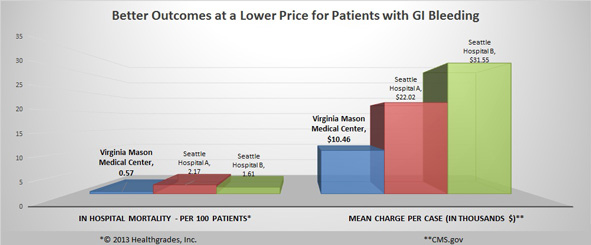Gastrointestinal (GI) bleeding is a symptom of a disorder in your digestive tract. The blood often appears in stool or vomit but isn't always visible. The level of bleeding can range from mild to severe and life-threatening. Bleeding may come from any site along the GI tract, but is often divided into:
- Upper GI bleeding:
The upper GI tract includes the esophagus (the tube from the mouth to the stomach), stomach, and first part of the small intestine. - Lower GI bleeding:
The lower GI tract includes much of the small intestine, large intestine or bowels, rectum and anus.
Although finding the cause of GI bleeding can be difficult, sophisticated imaging technology can usually locate the problem, and minimally invasive procedures often can fix it. For questions related to gastrointestinal bleeding or to schedule an appointment with a gastroenterologist, call (206) 223-2319.
Symptoms of Gastrointestinal Bleeding
The amount of GI bleeding may be so small that it can only be detected on a lab test such as the fecal occult blood test. Other signs of GI bleeding can include:
- Dark, tar-like stools
- Larger amounts of blood passed from the rectum
- Small amounts of blood in the toilet bowl, on toilet paper, or in streaks on stool
- Vomiting blood
Diagnosing Gastrointestinal Bleeding
Diagnosis for the cause of GI bleeding usually involves a medical history, including a history of symptoms and any changes in bowel habits, a physical examination, and diagnostic tests that include a blood test and stool test.
Your physician may also perform a procedure called an endoscopy or a colonoscopy. These procedures can find the source of bleeding as well as stop the bleeding.
A common presentation for GI bleeding is chronic iron deficiency anemia that is otherwise unexplained.
Treating Gastrointestinal Bleeding
Depending on the source of your GI bleeding (upper or lower digestive tract), the following treatment options may be considered:
- Endoscopic thermal probe can stop bleeding from ulcers and other abnormalities by burning (coagulating) the blood vessel or abnormal tissue.
- Argon plasma coagulation and radiofrequency ablation are other types of thermal techniques used to treat abnormal blood vessels in the stomach, small intestine and colon.
- Endoscopic clips can be used to close a bleeding vessel or other defective tissue.
- Endoscopic band ligation uses special bands to treat bleeding hemorrhoids and bleeding blood vessels (varices) in the esophagus.
- Endoscopic cryotherapy freezes abnormal blood vessels in the stomach.
- Endoscopic intravariceal cyanoacrylate injection uses a special glue to treat difficult bleeding from varices in the stomach.
- Angiographic embolization injects particles directly into a blood vessel to stop bleeding.
If bleeding recurs after treatment, you may need surgery.
Why should you go to Virginia Mason for Gastrointestinal Bleeding?
Patients with gastrointestinal bleeding that are treated at Virginia Mason’s Digestive Disease Institute not only experience better outcomes related to their condition, including lower mortality rates, but also have lower costs than other local medical institutions.
